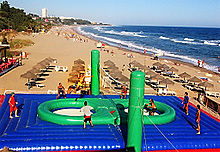Bossaball Becomes a New Trend in the World of Sports
Bossaball – a sport originating from Spain and Brazil, combining elements of volleyball, soccer, gymnastics, and capoeira. It is played on a rubber court with trampolines on either side. Each team consists of 3 to 5 players, and the object of the game is to score points by hitting the ball over the net to the opponent’s side of the court, using any part of the body (such as feet, hands, head, etc.). The rubber court allows players to perform acrobatic moves such as somersaults, making the sport exciting and visually impressive. Bossaball is quite popular in many countries, both in recreational and competitive settings.
History and Origins of Bossaball: From Spain to the World
Bossaball is a unique sport that combines elements of volleyball, soccer, capoeira, and gymnastics. It was first created by a Spanish entrepreneur, Philippe Hames, in 2004. Hames was inspired to create a new sport that prioritized entertainment, acrobatics, and dynamics, and could be played by people of all ages. He designed a Bossaball court made of rubber with trampolines on either side of the net, giving players the freedom to jump and spin in the air, similar to various acrobatic sports.
Although Bossaball originated in Spain, the sport quickly gained a warm welcome in Brazil, which is known for its strong soccer culture. In a short time, Bossaball spread to other countries, from Europe to Asia, even becoming an attraction at international sporting events. The uniqueness of Bossaball lies in the fact that players can use almost their entire body to hit the ball, including their head, feet, and other body parts, which makes it very entertaining to watch.
In a game of Bossaball, two teams of 3 to 5 players each try to score points by hitting the ball over a net to the opposing side. Trampolines on the court allow players to perform spectacular moves, including somersaults and acrobatic kicks, making this sport more than just a ball game.
Combining Sports and Acrobatics: The Uniqueness of Bossaball
Bossaball is a sport that emphasizes the combination of ball games and acrobatic movements. Created in 2004 by Philippe Hames in Spain, Bossaball combines elements of volleyball, soccer, capoeira, and gymnastics in one game. The main uniqueness of Bossaball is the use of a rubber field equipped with trampolines on both sides of the net, allowing players to jump and perform spectacular movements in the air.
The game is played by two teams of 3 to 5 players each. Each team tries to score points by hitting the ball over the net using any part of the body, including the feet, hands, and head. The trampolines on the field provide opportunities for players to perform acrobatics, such as somersaults and spinning kicks, which not only add to the excitement of the game but also make it very interesting to watch. Players not only rely on their skills in passing the ball, but also must have extraordinary agility and physical ability to master the trampolines.
Another uniqueness is the flexible nature of the game, where players of all ages and abilities can participate. Bossaball demands a combination of physical agility and creativity, where players can explore various tricks and techniques to score points. Therefore, this sport not only emphasizes strategy and teamwork, but also emphasizes the beauty of acrobatic movements that add to its own appeal.
Physical and Mental Benefits of Playing Bossaball
Bossaball is not only an exciting entertainment, but also offers many physical and mental benefits to its players. This sport combines various physical elements such as jumping, kicking, and acrobatic movements, which provide excellent cardiovascular exercise. Thanks to the trampolines on the field, players can improve leg strength, agility, and body balance. Every movement made, whether it is jumping high to kick the ball or spinning in the air, helps strengthen the body’s muscles, increase flexibility, and improve coordination.
In addition to the physical benefits, playing Bossaball also provides significant mental benefits. In this game, players are required to think quickly and work together as a team to achieve victory. This trains strategy skills, concentration, and decision-making abilities in stressful situations. Players also often face new challenges, such as mastering acrobatic tricks or timing a jump correctly, which can increase self-confidence.
The variety of movements in Bossaball can also help reduce stress. Intense physical activity will stimulate the production of endorphins, hormones that can improve mood and reduce anxiety. In addition, the fun and energetic atmosphere of the game encourages players to stay motivated and enjoy every moment, both during training and in competition. Overall, Bossaball not only provides benefits for the body, but also for the mental well-being of its players.
The Evolution of Bossaball: From Recreational to Competitive Sport
Bossaball was first created in 2004 by Philippe Hames in Spain with the goal of creating a sport that combined elements of volleyball, soccer, and acrobatics. It began as a fun recreational activity, played on a rubber court with trampolines on either side of the net. Combining acrobatic moves, Bossaball quickly caught the attention of people around the world due to its dynamic and energetic nature. Initially, the game was played more often on beaches or at casual events, and focused more on fun than competition.
However, over time, Bossaball began to develop into a more organized and competitive sport. The first Bossaball matches were held in Spain, and its popularity began to spread to Brazil, Europe, and other countries. International tournaments and championships began to be held, allowing players to compete at a higher level. The International Bossaball Organization was formed to regulate the rules and introduce the sport to the global market.
With the growing number of professional teams and loyal fans, Bossaball is now known not only as a recreational sport but also as a competitive sport that emphasizes strategy, agility, and teamwork. This evolution opens up opportunities for athletes to develop their skills in mastering complex acrobatic techniques and combining elements of traditional sports in one unique game.




